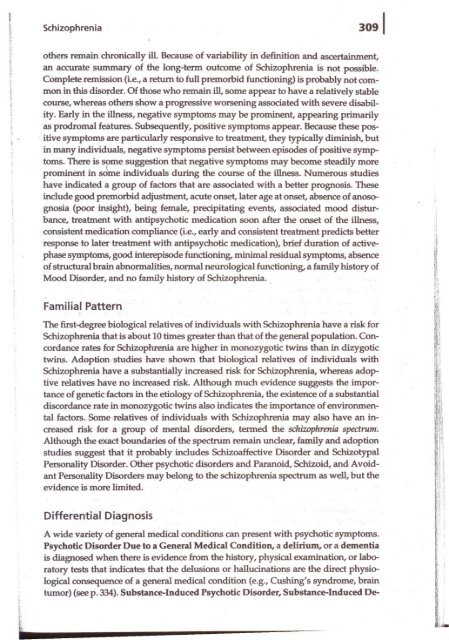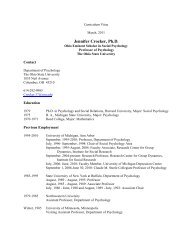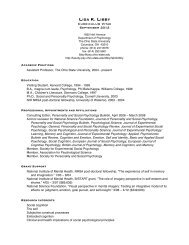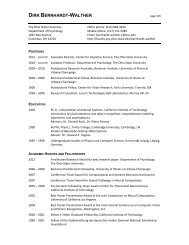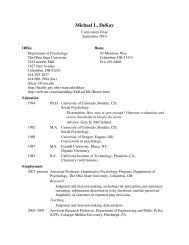Schizophrenia and Other Psychotic Disorders pg297-315.pdf
Schizophrenia and Other Psychotic Disorders pg297-315.pdf
Schizophrenia and Other Psychotic Disorders pg297-315.pdf
Create successful ePaper yourself
Turn your PDF publications into a flip-book with our unique Google optimized e-Paper software.
<strong>Schizophrenia</strong><br />
others remain' chronically ill. Because of variability in definition <strong>and</strong> ascertainment,<br />
an accurate summary of the long-term outcome of <strong>Schizophrenia</strong> is not possible~<br />
Complete remission (Le., a return to full premorbid functioning) is probably not common<br />
in this disorder. Of those who remain ill, some appear to have a relatively stable<br />
course, whereas others show a progressive worsening associated with severe disability.<br />
Early in the illness, negative symptoms may be prominent, appearing primarily<br />
as prodromal features. Subsequently, positive symptoms appear. Because these pos-<br />
. itive symptoms are particularly responsive to treatment, they typically diminish, but<br />
in many individuals, negative symptoms persist between episodes of positive symptoms.<br />
There is some suggestion that negative symptoms may become steadily more<br />
prominent in so~e individuals during the course of the illness. Numerous studies<br />
have indicated a group of factors that are associated with a better prognosis. These<br />
include good premorbid adjustment, acute onset, later age at onset, absence of anosognosia<br />
(poor insight), being female, precipitating events, associated mood distllibance,<br />
treatment with antipsychotic medication soon after the onset of the illness,<br />
consistent medication compliance (i.e., early <strong>and</strong> consistent treatment predicts better<br />
response to later treatment with antipsychotic medication), brief duration of activephase<br />
symptoms, good interepisode functioning, minimal residual symptoms, absence<br />
of structural brain abnormalities, normalneillologicalfunctioning, a family history of<br />
Mood Disorder, <strong>and</strong> no family history of <strong>Schizophrenia</strong> ..<br />
Familia' Pattern<br />
The first-degree biological relatives of individuals with <strong>Schizophrenia</strong> have a risk for<br />
<strong>Schizophrenia</strong> that is about 10 times greater than that of the general population. Concordance<br />
rates for <strong>Schizophrenia</strong> are higher in monozygotic twins than in dizygotic<br />
twins. Adoption'studieshave shown that biological relatives of ,individuals With<br />
<strong>Schizophrenia</strong> have a substantially increased. risk for <strong>Schizophrenia</strong>, whereas adoptive<br />
relatives have no increased risk. Although much evidence suggests the importance<br />
of genetic ,factors in the etiology of <strong>Schizophrenia</strong>, the existence of a substantial<br />
discordance rate in monozygotic twins also indicates the importance of environmental<br />
factors.; Some .relatives .of individuals with <strong>Schizophrenia</strong> may also have an in;..<br />
creased risk· for a' group of mental disOrders, termed the schiiophrenia spectrum:<br />
Although the exact boundaries of the spectrum remain unclear, family <strong>and</strong> adoption<br />
studies suggest that it probably includes Schizoaffective Disorder <strong>and</strong> Schizotypal<br />
Personality Disorder. <strong>Other</strong> psychotic disOrders <strong>and</strong> Paranoid, Schizoid; <strong>and</strong> Avoidant<br />
Personality <strong>Disorders</strong> may belong to the schizophrenia spectrum as well; but the<br />
evidence is more limited.<br />
Differentia ,"Diagnosis<br />
A wide variety of general medical conditions can present with psychotic symptoms.<br />
<strong>Psychotic</strong> Disorder Due to a General Medical Condition, a delirium, or a dementia<br />
is diagnosed when there is evidence from the history, physical examination, or laboratory<br />
tests that indicates that the delusions or hallucinations are the direct physiological<br />
cOnSequence of a general medical condition (e.g., Cushing's syndrome, brain<br />
tumor) (see p.334). Substance-Induced <strong>Psychotic</strong> Disorder, Substance-Induced De- I<br />
t·;<br />
.';<br />
".1.


